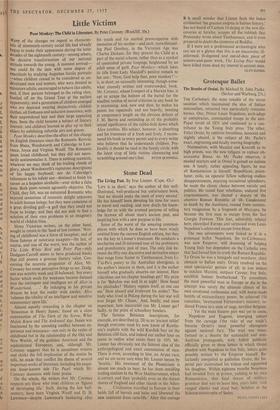Little Victims
Poor Monkey: The Child in Literature. By Peter Coveney. (Rockliff, 30s.) MANY of the changes we regard as character- istic of nineteenth-century social life had already begun to make their appearance during the latter decades of the eighteenth century—among others, the decisive transformation of our national attitude towards the young. A moment arrived— one could fix the date with some degree of exactitude by studying Augustan family portraits —when children ceased to be considered as un- developed men and women, who were dressed as miniature adults, encouraged to behave like adults, and, if their parents belonged to the ruling class, bustled off on the Grand Tour at the earliest opportunity; and a generation of children emerged who are depicted wearing distinctively childish clothes, all freshness and seductive innocence, with their unpowdered hair and their large appealing eyes. Soon the child became a subject of literary interest; and children learned to play up to their elders by exhibiting infantile airs and graces.
Poor Monkey describes the effect of this change on English literature since the Romantic Revival, from Blake, Wordsworth and Coleridge to Law- rence, Joyce and Virginia Woolf. The Romantic poets loved childhood; but they did not neces- sarily sentimentalise it. There is nothing mawkish, whatever we may think of his trailing clouds of glory, about Wordsworth's rapturous descriptions of his happy boyhood; nor do Coleridge's references to his infant son—destined to finish his career as a hopeless alcoholic—ever strike a false note. Both poets remain agreeably objective. The Child, they felt, was an untutored Romantic who enjoyed sensations of romantic delight unknown to adult human beings; but they were conscious of a great dividing gulf—a gulf that they could not hope to bridge; and they did not seek to find a solution of their own problems in an imaginary world of childish bliss.
Many Victorian writers, on the other hand, sought to return to the 'land of lost content.' Writ- ing of childhood was a form of escapism; and of these famous or notorious escapists—the last, of course, and one of the worst, was the author of The Little White Bird and Peter Pan—only Dodgson-Carroll seems to have produced books that still possess a genuine literary value. Con- cerning the neurotic progenitor of Alice, Mr. Coveney has some perceptive things to say. Dodg- son was notably weak and ill-balanced; tut every factor which made for weakness became focused into the astringent and intelligent art of Alice in Wonderland. . . .' By indulging in his private dreams he kept the reader wide awake; Alice 'releases the vitality of an intelligent and sensitive commentary upon life.' Almost equally rewarding is the chapter on 'Innocence in Henry James,' based on a close examination of The Turn of the Screw, What Maisie Knew and The Awkward Age. James was fascinated by the unending conflict between ex- perience and innocence—not only in the realm of childhood but in the relationship of the Old and New Worlds, of the guileless American and the sophisticated European; and, although Mr. Coveney suggests that he is sometimes evasive and shirks the full implication of the stories he tells, he made that conflict the theme of several important works of literature, including his exqui- site lesser-known tale The Pupil which Mr. Coveney dismisses with faint praise.
On the whole, the writers that Mr. Coveney respects are those who treat children as 'figures of developing life.' Such, during the last half- century, have been Virginia Woolf and D. H. Lawrence—despite Lawrence's hankering after
his youth and his morbid preoccupation with memories of his mother—and such, notwithstand- ing Paul Dombey, in the Victorian Age was Charles Dickens; for they present the Child as a part of the social scheme, rather than as a symbol of unsatisfied private longings, heightened by an adult sense of guilt. Poor Monkey—which takes its title from Lady Macduff's pensive remark to her son : 'Now, God help thee, poor monkey!'— is, in short, an unusually interesting, though some- what clumsily written and overcrowded, book. Mr. Coveney, whom I suspect of a Marxist bias, is apt to scrape the bottom of the barrel for the smallest residue of social criticism in any book he is examining; and, now and then, he makes his points too repeatedly and too heavily, insisting at unnecessary length on the obvious defects of J. M. Barrie and reminding us of the probably sexual significance of the rabbit-hole down which Alice tumbles. His subject, however, is absorbing and his treatment of it fresh and lively. I recom- mend his book to every parent and to every writer who believes that he understands children. Pre- ferably it should be read in the family circle, with the latest crop of little victims clamouring and
scrambling around one's feet. PETER QUENNELL


























 Previous page
Previous page